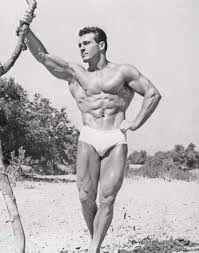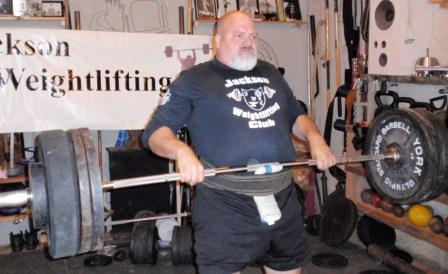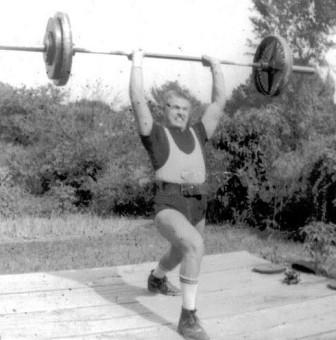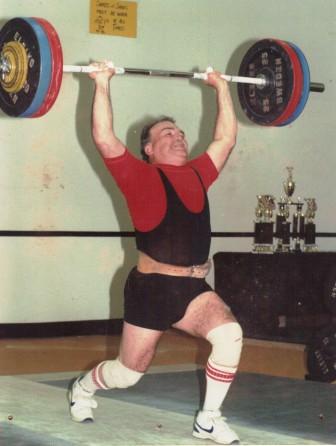by John McKean
THE 2011 USAWA CLUB CHALLENGE – THICK AS GRAVY
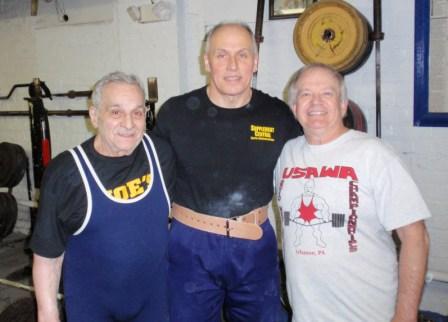
The Ambridge Barbell Club hosted this years USAWA Club Challenge. Pictured left to right: Art Montini, Phil Rosenstern, and John McKean.
I sure hope that nutritionists will discover that the Maple Restaurant’s famed thick, brown beef gravy is chock full of protein, vitamins, and minerals! Our hungry Club Challenge competitors sure slurped a lot of the delicious sauce down with big beef platters!! Joe Ciavattone Jr had been looking forward to this stuff all day (he even had his girlfriend research online the restaurant BEFORE he, his dad, and brother had left Boston!), and I think Chad and Al ordered an extra quart of the gravy as their beverage!! But it was an absolutely wonderful meal that capped off a perfect lifting day – truly a family gathering of happy and starving USAWA men who had traveled from Kansas, Boston, Lebanon, Cleveland, Pittsburgh, and Aliquippa!!
Actually air flight arrangements were a bit off, with our Kansas group not being able to arrive before 2:30, but that eventually proved to be a big plus. While waiting, the rest of us hit the Ambridge gym at about 11 AM, and ended up setting sort of a record in itself – we actually completed FOUR meets within one afternoon!! That is, we conducted a “Record Day”, 2 postal competitions, and then, well warmed, the Club Challenge.
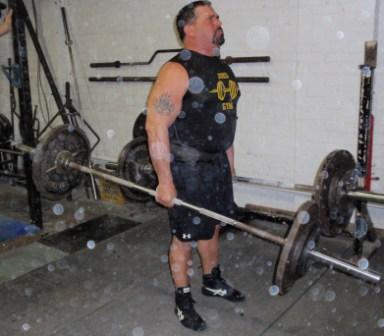
Joe Ciavattone Sr., of Joe's Gym, performing an outstanding 2-Barbell Deadlift.
We have to give a huge thanks to co-meet director Art Montini for his skillful airport pickup & delivery system!! Joe Ciavattone & sons were obviously a bit concerned when arriving at 9 AM on Friday morning at the big Pittsburgh terminal, heading toward the outside doors, and there was ole smiling Art at the ready! They spent a relaxing day & night at Art’s place -as Joe told me “I can’t ever remember being this relaxed going into a contest!” Then, on Saturday afternoon, after lifting most of the day, ever energetic Art headed for the airport with perfect timing to intercept Al, Chad, and Darren ! They were back almost before we could get our second breath, and put us in real pain, as we entered into the main event !
As we warmed up, we had an unexpected treat -longtime powerlifter and Ambridge VFW member, 57 year old Phil Rosenstern, of deadlifting fame, was so impressed with the goings on (Phil was just innocently doing a normal Saturday workout when the craziness overtook him!) that he immediately joined the USAWA, then hoisted a world record hack lift of 450 at 198 pounds bodyweight !! It was fast, easy, and perfect, performed in front of 7 top level officials!! Welcome aboard, Phil !
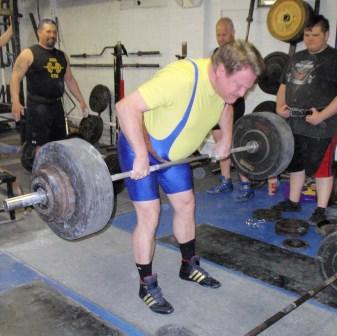
Scott Schmidt joined the Ambridge Club for this team event and is showing perfect technique in his 253 pound Bent Over Row.
The meet went in our usual “scatter fashion” with groups doing the 2 barbell deadlift, bent over row, and neck lift in various corners of the VFW pit. It worked to perfection, with everyone encouraging another to the very best efforts. Even the jet lagged crew from Kansas summoned their “inner animal” toward the end, with both Chad & Al neck lifting phenomenal 750 pound fourth attempts! Their newcomer (to the Steel Valley) team mate, Darren was awesome in leading the Western men into battle, earlier having done a terrific, balanced 470 pound 2 barbell deadlift.
What more can be said about the Ciavattones – other than they are the strongest family team in the USAWA ?!! It was just fantastic to see old buddy Joe & his teen sons Joe Jr and Jon! And these men came to lift heavy, sticking at it all day,with records vanishing through their strong hands! Not to mention thick NECKS – these three guys set the bar for neck lifting standards at this contest; it was their collective performance that inspired me to include this lift in the contest (despite all the grief EVERYONE gave me about this painful harness event!!!).
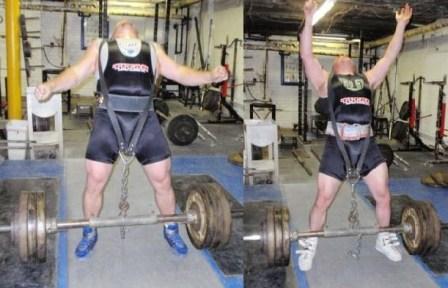
Dino Gym teammates Chad Ullom and Al Myers both ended the day with record performances in the Neck Lift, each with a lift of 750 pounds.
Denny and Kohl once again brought “knives to a gunfight”, as they were the two man team in a three man event!! So, naturally, they won the two man team award with their usual record breaking prowess. I think they also had the meet record for the longest TIME traveled during that day with a round trip to/from Lebanon (PA) of about 12 hours (despite moans & groans about layovers from a certain group of cowboys!).
And what would a meet be without the smooth talking (he convinced the Maple restaurant over the phone to remain open for our after meet dinner!!) Scott Schmidt to drive over from Cleveland to be Ambridge’s third team member for the day? Scott did his usual stellar, perfect form performance, and even inspired old Art into setting 4 new Master’s records!
As Al summed up over dinner, the Club Challenge is certainly well established now as one of the USAWA’s premier events. We just may have more fun & comradary at this contest than any other! Next year let’s shoot for 10 teams!!!
FULL MEET RESULTS
2011 Club Challenge
Ambridge VFW BBc
Ambridge, PA
March 12th, 2011
Meet Directors: John McKean and Art Montini
Officials: (3-official system used on all lifts): John McKean, Art Montini, Denny Habecker, Scott Schmidt, Joe Ciavattone Sr., Al Myers, Chad Ullom, Darren Barnhart
Lifts: Deadlift – 2 Bars, Bent Over Row, Neck Lift
1. Dino Gym – 3192.35 Adjusted Points
| Lifter |
Age |
BWT |
DL |
Bent |
Neck |
| Al Myers |
44 |
248 |
590 |
300 |
550 |
| Chad Ullom |
39 |
238 |
510 |
285 |
550 |
| Darren Barnhart |
43 |
285 |
470 |
285 |
400 |
2. Joe’s Gym – 3066.05 Adjusted Points
| Lifter |
Age |
BWT |
DL |
Bent |
Neck |
| Joe Ciavattone Sr. |
42 |
254 |
410 |
285 |
600 |
| Joe Ciavattone Jr. |
17 |
220 |
410 |
205 |
550 |
| Jonathon Ciavattone |
16 |
234 |
350 |
184 |
550 |
3. Ambridge BBC – 2773.84 Adjusted Points
| Lifter |
Age |
BWT |
DL |
Bent |
Neck |
| John McKean |
65 |
175 |
370 |
209 |
350 |
| Art Montini |
83 |
179 |
238 |
100 |
250 |
| Scott Schmidt |
58 |
251 |
363 |
253 |
264 |
4. Habecker’s Gym – 1679.02 Adjusted Points
| Lifter |
Age |
BWT |
DL |
Bent |
Neck |
| Denny Habecker |
68 |
188 |
290 |
209 |
270 |
| Kohl Hess |
16 |
285 |
410 |
220 |
300 |
All lifts recorded in pounds and adjusted points are adjusted for bodyweight correction and age allowance.
Extra attempts for Record:
Chad Ullom – Bent Over Row 300#
Chad Ullom – Deadlift, 2 Bars 550#
Chad Ullom – Neck Lift 750#
Al Myers – Neck Lift 750#
Record Day Session
John McKean – 175 pounds BWT, 65 years of age
Hack Lift – Fulton Bar: 195#
Squat: 225#
Jefferson Lift – Fulton Bar: 300#
Deadlift – Fulton Bar: 300#
Phil Rosenstern – 198 pounds BWT, 57 years of age
Hack Lift: 450#
Scott Schmidt – 251 pounds BWT, 58 years of age
Pinch Grip – Right Hand: 136#
Pinch Grip – Left Hand: 99#
